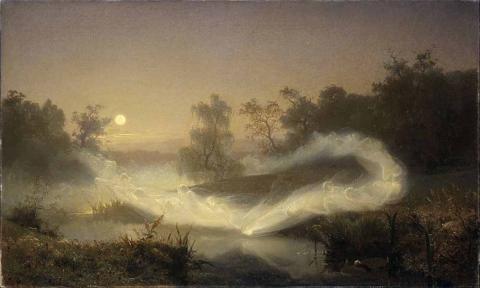Excerpt from an interview with Jeremy Harte by Alicia McDermott
Jeremy Harte maps the borderlands where folklore meets landscape and the supernatural. His books include Explore Fairy Traditions, The Green Man, and Cloven Country: The Devil and the English Landscape. In between organizing events for the Folklore Society, he works as curator of Bourne Hall Museum in Surrey.
AM: Please tell us about a couple interesting superstitions surrounding death and ghosts in medieval Britain.
JH: There were a lot of dead people walking in medieval England, then as now: the difference was that the living knew how to deal with them. A ghost needed absolution from sin and the prayers of the living, which would free it from an in-between state and progress it to Heaven. During their lives, people spent a lot of time and money reducing their future time in purgatory to a minimum, but they never felt secure. The ghosts are a reminder of that; and they pinpoint the things that were on people’s minds as they lay dying. Money and family, mostly.

Detail of a replica of a 1490 Dance of Death fresco. National Gallery of Slovenia. (Public Domain)
AM: How has the appearance/image of ghosts changed over time?
JH: The biggest difference in English lore is that whereas ghosts used to appear as shape-shifters – animals, burning haystacks, flapping canvas – they now look just like people, until they vanish. The other difference is that they used to draw on a mental template of goblin shapes, while they now reflect our ideas of historical costume and can appear as Romans, Cavaliers etc. This was impossible until recently because ordinary people had no idea what someone from the past looked like.
AM: Why are supernatural beings, such as ghosts and fairies, said to haunt/inhabit certain areas more than others?
JH: There are three explanations on offer for this. 1, different places are physically more or less suited to holding spirits or letting them through from elsewhere. 2, different places have different effects on what people are prepared to see, without percipients being aware of it, through shadows, echoes, ultrasound, underground streams. 3, some places are suitable stage sets for embodying a story of experience, like ruined abbeys, or mounds on hills. When you think about questions, the golden rule is: don’t ask yourself if it could be possible, ask what evidence you would expect to see if it were true and what you’d see if not. Actually, medieval supernaturals are always described relative to people, not place.
AM: In your book Cloven Country you discuss stories involving the Devil in relation to English landscapes, what are the implications of these tales for the people living in the locations today?
JH: Tourism! People will walk past a rock but if you call it the Devil’s Armchair they’ll stop, look, and buy a postcard. These traditions are about treating the landscape in a more imaginative way, which is why they often begin as a name and only later develop a story. Then it’s good to be a local, because you were brought up with the story, and outsiders don’t know it. The only people to take it further are kids, who are hypersensitive to atmosphere and love being frightened: if you can raise him by running round the Devil’s Stone seven times, they’ll do it for six rounds and then bottle out on the seventh.
Get the whole story: read the full interview in the September - October 2023 issue of Ancient Origins Magazine. Get it here!
Featured Image: ‘Dancing Fairies’ (1866) by August Malmström. Source: Public Domain
By Alicia McDermott




